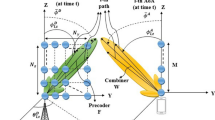Abstract
Spatial multiplexing is used in multiple input multiple output (MIMO) wireless systems to increase the data rate. Some nonlinear detectors, such as minimum mean square error (MMSE) Vertical Bell laboratories layered space-time (VBLAST), Maximum A-Posteriori (MMSE VBLAST MAP), and MMSE Improved VBLAST detectors are used in place of a over more complex detector, such as maximum likelihood detector or singular value decomposition based detector. We have presented simulation results of MIMO symbol error rate versus average SNR for MMSE VBLAST MAP and MMSE Improved VBLAST schemes assuming spatially correlated channels for M-ary QAM. We have observed that the performance of MMSE VBLAST MAP and MMSE Improved VBLAST detectors is almost identical in spatially uncorrelated channels. However, in the case of spatially correlated channels, MMSE Improved VBLAST outperforms MMSE VBLAST MAP. We have also seen that complexity of the Improved VBLAST algorithm is higher than the complexity of VBLAST MAP algorithm.
Similar content being viewed by others
References
G. J. Foschini, “Layered space time architecture for wireless communication in a fading environment when using multi-element antennas,” Bell Labs Technical Journal 1, No. 2, 41 (Autumn 1996). DOI: 10.1002/bltj.2015.
G. J. Foschini and M. J. Gans, “On limits of wireless communications in a fading environment when using multiple antennas,” Wireless Personal Communications 6, No. 3, 311 (1998). DOI: 10.1023/A:1008889222784.
V. B. Kreyndelin and L. A. Varukina, “A method of modulating signals with space-time encoding using non-linear iteration algorithm,” Radioelectron. Commun. Syst. 52, No. 8, 413 (2009). DOI: 10.3103/ S0735272709080032.
E. Agrell, E. Eriksson, A. Vardy, and K. Zeger, “Closest point search in lattices,” IEEE Trans. Inf. Theory 48, No. 8, 2201 (Aug. 2002). DOI: 10.1109/TIT.2002.800499.
Zhan Guo and Peter Nilsson, “Reduced complexity Schnorr-Euchner decoding algorithms for MIMO systems,” IEEE Commun. Lett. 8, No. 5, 286 (May 2004). DOI: 10.1109/LCOMM.2004.827376.
Vipul Gupta, Abhay Kumar Sah, and A. K. Chaturvedi, “Approximate matrix inversion based low complexity sphere decoding in MIMO systems,” arXiv: 1509.02405v1 [cs.IT] (8 Sept. 2015).
M. Kanthimathi, R. Amutha, “Reduced complexity maximum likelihood detection for DAPSK based relay communication systems,” Proc. of 2015 Int. Conf. on Computing and Communications Technologies, ICCCT, 8 Oct. 2015, Chennai, India (IEEE, 2015), pp. 292–295. DOI: 10.1109/ICCCT2.2015.7292763.
Yi-Jun Zhu, Wen-Ya Wang, Jian-Kang Zhang, Yan-Yu Zhang, “Constellation collaborated non-linear orthogonal space-time block codes with fast maximum-likelihood detection,” IEEE Trans. Vehicular Technology 66 No. 1, 513 (2017). DOI: 10.1109/TVT.2016.2536060.
Yin Chen and Xu Guang Huang, “A linewidth-tolerant two-stage CPE using a new QPSK-partitioning approach and an enhanced maximum likelihood detection for 64-QAM coherent optical systems,” J. Lightwave Technology 33, No. 18, 3883 (2015). DOI: 10.1109/JLT.2015.2448113.
Nir Regev, IIia Iofedov, and Dov Wulich, “Maximum likelihood detection of nonlinearly distorted OFDM signal,” Proc. of 2015 IEEE Global Communication Conf., GLOBECOM, 6-10 Dec. 2015, San Diego, CA, USA (IEEE, 2016), pp. 1–6. DOI: 10.1109/GLOCOM.2015.7417009.
P. W. Wolniansky, G. J. Foschini, G. D. Golden, and R. A. Valenzuela, “V-BLAST: An architecture for realizing very high data rates over the rich-scattering wireless channel,” Proc. of Int. Symp. on Signal, System and Electronics (1998), pp. 295–300. DOI: 10.1109/ISSSE.1998.738086.
A. Alimohammad, S. F. Fard, and B. F. Cockburn, “Improved layered MIMO detection algorithm with near-optimal performance,” Electron. Lett. 45, No. 13, 675 (2009). DOI: 10.1049/el.2009.0373.
Yavuz Yapici, “A new symbol detection algorithm for MIMO channels,” A thesis submitted to the department of electrical and electronics engineering and the institute of engineering and science of Bilkent university (Jan. 2005).
Dimitry Chizhik, Farrokh Rashid Farrokhi, Jonathan Ling, and Angel Lozano, “Effect of antenna separation on the capacity of BLAST in correlated channels,” IEEE Commun. Lett. 4, No. 11, 337 (Nov. 2000). DOI: 10.1109/ 4234.892194.
Sergey L. Loyka, “Channel capacity of MIMO architecture using the exponential correlation matrix,” IEEE Commun. Lett. 5, No. 9, 369 (Sept. 2001). DOI: 10.1109/4234.951380.
Author information
Authors and Affiliations
Corresponding author
Additional information
Original Russian Text © D. Chauhan, J. Bhalani, 2017, published in Izvestiya Vysshikh Uchebnykh Zavedenii, Radioelektronika, 2017, Vol. 60, No. 7, pp. 383–391.
About this article
Cite this article
Chauhan, D., Bhalani, J. Performance of nonlinear detectors in spatial multiplexing for spatially correlated channels. Radioelectron.Commun.Syst. 60, 297–302 (2017). https://doi.org/10.3103/S0735272717070020
Revised:
Published:
Issue Date:
DOI: https://doi.org/10.3103/S0735272717070020




